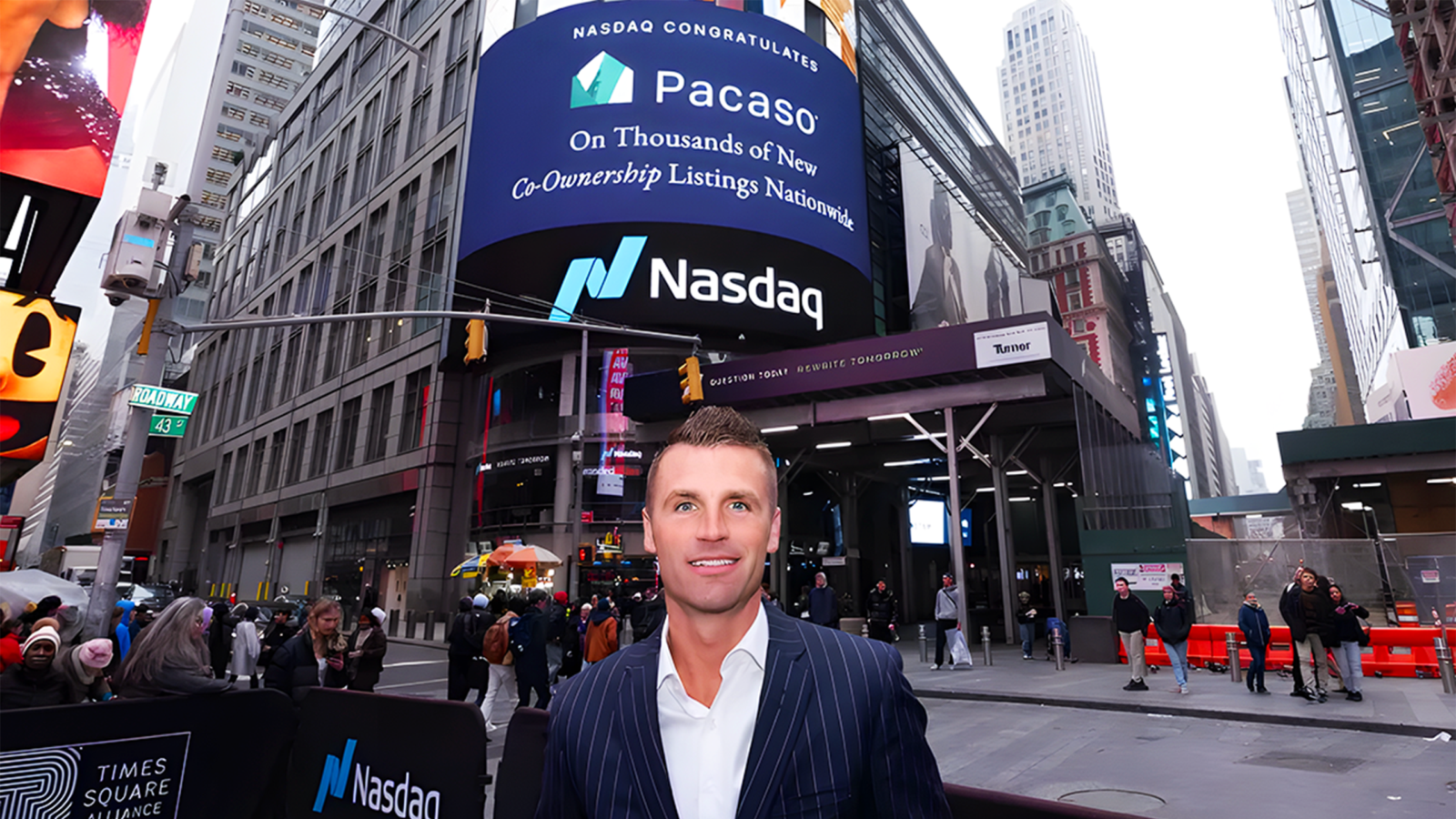Good morning.
Nothing says summer’s over like the release of Starbucks’ fall menu. The world’s largest coffee chain unveiled its annual autumnal specials on Tuesday, including the wildly popular Pumpkin Spice Latte that comedian John Oliver once described as “coffee that tastes like a candle.”
The longtime staple of the seasonal menu joins the returning Pumpkin Cream Cold Brew, Iced Pumpkin Cream Chai Tea Latte and Pecan Crunch Oatmilk Latte. Brand new on offer is the Pecan Oatmilk Cortado, or coffee that tastes like a different candle.
AT&T Strikes $23B Deal for EchoStar 5G Spectrum Licenses

In the wireless wars, surrender is a dish best served … actually, either hot or cold is just fine as long as it’s lavish.
After spending years and billions of dollars to build a nationwide 5G network, Dish Network’s parent company, EchoStar, said Tuesday it has agreed to sell a basket of spectrum licenses to AT&T for a whopping $23 billion. Shares of EchoStar surged on news of the deal, the proceeds of which it said will go toward retiring debt and funding its growth operations. AT&T, meanwhile, says the splurge will help fuel its 5G ambitions.
If You’re Not Fourth, You’re Last
EchoStar’s 5G ambitions date to 2019 and are a byproduct of another major telecom deal, T-Mobile’s acquisition of Sprint. When reviewing that mega-merger, the US Department of Justice wanted to preserve access for US wireless customers to a fourth major carrier. Dish (which spun off from EchoStar in 2008, only to merge back into the parent company in 2023) entered the fray by acquiring prepaid wireless provider Boost Mobile and certain Spectrum assets from Sprint and T-Mobile for approximately $5 billion.
In the following years, Dish and EchoStar spent billions of dollars to build out their 5G network, which the reconciled couple said in Federal Communications Commission filings last year reached roughly 80% of Americans. The big problem? Nobody uses it:
- Boost Mobile has lost customers since Dish acquired it, servicing around 7 million wireless customers, down from around 9 million in 2020. And while that technically makes it the fourth-largest mobile carrier, it’s far from being the major competitor the FCC sought. Verizon, T-Mobile and AT&T each have well north of 100 million subscribers, and together, they control more than 90% of the US market.
- In April, Elon Musk even complained to the FCC that EchoStar was essentially hogging precious airwave space for no reason. Shortly after, the agency opened an investigation into the company’s allegedly slow buildout toward becoming a true No. 4, which FCC Chair Brendan Carr indicated in July isn’t necessarily a “magic number.”
Exit Strategy: There have been more bumps for EchoStar. In May, the company copped to skipping a $326 million cash interest payment amid the FCC probe, while sources told The Wall Street Journal in June that the company was even considering filing for Chapter 11 bankruptcy. Which is why its exit now is hardly surprising, especially given the price. According to a New Street Research note to clients seen by Bloomberg on Tuesday, AT&T is paying $9 billion more than EchoStar paid for the spectrum and about $5 billion more than the appraised value used in securitizing the assets. New Street called the sale price “a great mark-on value,” and EchoStar’s share price spiked 70% on Tuesday, following the news. All in all, not a bad payday for a distant fourth, though definitely not what Congress had in mind.
It’s Not Publicly Traded, But 10,000+ Investors Already Own This Stock

Not only have over 10,000 everyday investors bought shares, but some of Wall Street’s biggest players have, too. These are some of the big investors who backed names like Uber and eBay before they IPO’d.
The company they’re backing now? Pacaso.
Founded by a Zillow executive, Pacaso is bringing co-ownership to the $1.3T vacation home market.
And it’s been wildly successful. Over 2,000 people have owned through Pacaso, generating $110M in gross profits for the company to date. With a global expansion into top destinations like Italy and the Caribbean underway, this is just the start.
You can share in their potential, too. But the opportunity to invest ends on Sept. 18.
Join 10,000 investors by becoming a Pacaso shareholder here.*
Eli Lilly Captures Major Lead in Weight-Loss Pill Race
Eli Lilly tipped the scales Tuesday, announcing a successful trial of its weight-loss pill that led stock in competitors to shed some muscle mass.
The pharmaceutical giant now has the trial data in hand to seek approval from regulators around the world, meaning its pill orforglipron could soon swallow a large chunk of the highly lucrative GLP-1 drug market.
No More Needling
GLP-1 drugs, which reduce a person’s appetite by suppressing gut hormones, have unlocked a Scrooge McDuck vault’s worth of revenue for Indianapolis-based Lily and its main rival in the space, Denmark’s Novo Nordisk. The two companies brought in a combined $41 billion from the treatments last year. But Lilly’s Mounjaro and Zepbound and Novo’s Ozempic and Wegovy have, until now, had one sharp problem: needles are required to administer them.
Up to a quarter of adults are afraid of needles, according to the US Centers for Disease Control and Prevention, meaning a GLP-1 weight loss treatment in pill form could open up billions more in revenue by offering a phobia-free experience. As a result, Lilly and Novo have faced off in a veritable space race to get their own to market: In May, the US Food and Drug Administration accepted Novo’s application for an oral version of Wegovy, with a decision expected in the fourth quarter that could make it the first such pill to gain regulatory approval. But the late-stage trial results for Lilly’s pill come with the advantage of convenience:
- Unlike Novo’s pill — which must be taken on an empty stomach followed by a 30-minute waiting period before the patient eats, drinks or takes other medicine — Lilly’s pill comes with no dietary restrictions. The Indianapolis company reported that participants in its latest study lost an average of 22.9 pounds, or 10.5% of their body weight, when given the highest dose.
- Lilly said Tuesday that it’s now prepared to seek global regulatory approval for its pill this year, which drove its shares up 5.8%. Novo’s shares fell 1.8%, widening their decline this year to more than 35%, as Lilly and copycat drugs have eaten into its market share seemingly sans dietary restriction.
Viking’s Shipwreck: Morgan Stanley analysts have estimated that Lilly’s GLP-1 pill, when used to treat obesity and diabetes, could bring in as much as $40 billion in annual sales by 2033. Meanwhile, Viking Therapeutics, a relatively distant competitor developing its own GLP-1 pill, nudged up 0.7% on Tuesday. The company is still nursing wounds from last week, however, when it fell 40% in a single day following disappointing trial data.

Where The Vision Meets The Balance Sheet. The CEO sets the vision. The CFO keeps it financially grounded. When these roles align, strategy meets execution; when they don’t, the fallout is costly. In this guide, Financiario founder Oana Labes unpacks the skills, KPIs, and dynamics that define a winning CEO-CFO partnership. Unlock the Playbook.
IBM Joins Forces With AMD to Develop ‘Quantum-Centric Supercomputers’
Seventy-two years ago, in 1953, IBM introduced the 650 Magnetic Drum Data Processing Machine, the world’s first mass-produced computer. The CPU, power unit and card reader weighed well over 4,000 pounds and could manage payrolls, perform statistical analyses and handle engineering design calculations, all things a 2.7-pound MacBook Air can handle in 2025.
On Tuesday, the elder statesman of America’s tech giants announced it will partner with semiconductor powerhouse AMD to jointly develop so-called “quantum-centric supercomputers” that can handle algorithms so complex they would make your MacBook go up in smoke at the coffee shop.
Algorithmic Promise
If you don’t know what quantum computing is — or if you’ve tried to understand it but ended up feeling like it’s 1977 and the Grateful Dead are on stage at Barton Hall and your head is spinning — here’s the basic idea. Quantum computing involves building super-powered computers that use tiny particles like atoms to perform lots of calculations at once, rather than one at a time. This means they can solve complex problems much faster than normal computers, which is why Amazon, Google, IBM and Microsoft are investing in the technology. Quantum computers will be able to solve incredibly complex statistical problems in finance, engineering, green tech and climate change, pharmaceuticals and more by processing data with previously unheard-of speed and complexity. As a result, technological progress will accelerate.
IBM’s partnership with AMD aims to combine quantum computing with high-performance computing, which involves the use of lots of computing power, like supercomputers, to solve problems that are too much for a normal computer on its own. IBM quantum computers will be integrated with the advanced computing power of AMD’s CPUs, GPUs and FPGAs so the two can be used together. IBM has an explanation for how it may be helpful:
- “For example, in the future, quantum computers could simulate the behavior of atoms and molecules, while classical supercomputers powered by AI could handle massive data analysis,” the company said in a statement. “Together, these technologies could tackle real-world problems at unprecedented speed and scale.”
- IBM said the hybrid approach could help in achieving its goal of creating “fault-tolerant” quantum computers by the end of this decade. Qubits, the unit of quantum information that quantum computers work with, are prone to errors because they are highly sensitive to environmental factors like noise and heat. “AMD technologies offer promise for providing real-time error correction capabilities, a key element of fault-tolerant quantum computing,” IBM said.
Simple Multiples: McKinsey analysts estimated earlier this year that quantum computing could generate as much as $72 billion in revenue by 2035, up from $4 billion last year. They also forecast that quantum computing could unlock up to $1.3 trillion in economic value in the automotive, chemicals, financial services and life sciences sectors by 2035. It doesn’t take a supercomputer or a MacBook to tell you that’s a lot of dough.
Extra Upside
- Legal Standoff: Federal Reserve Board Governor Lisa Cook will sue the Trump administration over its bid to fire her, according to her lawyer.
- All the Generative Prompts Fit to Print: Activist investor Fivespan has built a stake in the New York Times and is urging the publisher to embrace artificial intelligence.
- Have An IPO That’s Incoming? Or maybe it’s delayed. Your equity plan needs prep either way. For tips on strategic IPO actions you can take now, from tax moves to cash-flow solutions, register for Aspiriant’s September 25 webinar on IPO preparedness. Get ready for your liquidity event.**
** Partner
Just For Fun
Disclaimer
*This is a paid advertisement for Pacaso’s Regulation A offering. Please read the offering circular at invest.pacaso.com. Reserving the ticker symbol is not a guarantee that the company will go public. Listing on the Nasdaq is subject to approvals.

